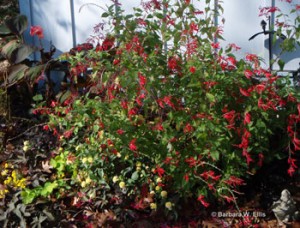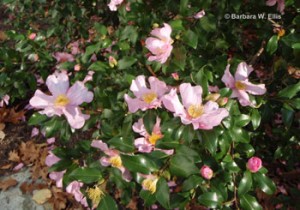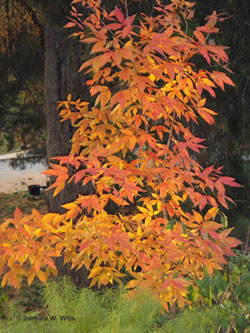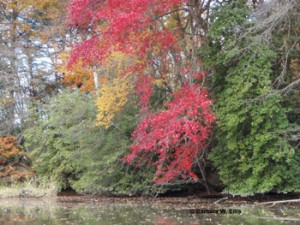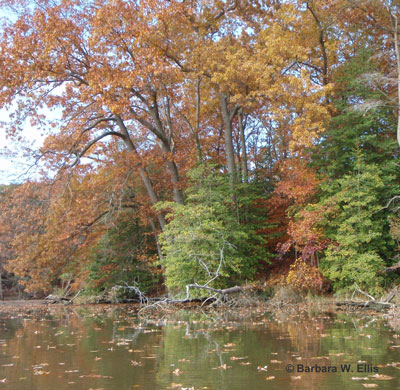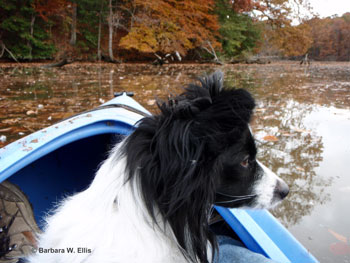Like most gardeners, I spend far too little time simply enjoying my garden and the natural world around it. IŌĆÖve followed both Garden Bloggers’ Bloom Day, hosted by May Dreams Gardens, for months now, and have also enjoyed all the fall foliage on the Garden Blogger Fall Foliage Project at The Home Garden. With todayŌĆÖs post, IŌĆÖm making a grateful nod to both of them, because both inspired me to spend some long-overdue time just observing and appreciating.
Fall flowers. We still havenŌĆÖt had a frost down here on MarylandŌĆÖs Eastern Shore, although my coleus is showing signs of its imminent departure. A few annuals and tender perennials remind me why I love them so: They bloom all summer long despite heat and humidity, plus they continue to add color right up to the first hard frost. ŌĆśLemon GemŌĆÖ marigolds top the list this year. Mounds of them still line the pathways of my main garden, although I couldnŌĆÖt get a picture of them today because the wind is blowing so hard off the creek. On a more protected side of the house, I still have lantana in bloomŌĆöa yellow-flowered cultivar whose name escapes meŌĆögrowing with a tender perennial that makes a major late-season contribution each year: pineapple sage (Salvia elegans). It is always shrub-size by the time it blooms and is covered for weeks with showy scarlet trumpets. There also are impossibly blue blooms remaining on salvia ŌĆśBlack and BlueŌĆÖ, another plant located on the windy side of the house that wouldnŌĆÖt sit still long enough for a picture.
Still, the best plant I have to report for Garden BloggerŌĆÖs Bloom Day is my fall-blooming camelia (Camellia sasanqua), which came to us with the house. (It survived the renovation draped in orange caution tape.) It produces an abundance of showy single pink flowers from late September through November and even into December if the weather stays relatively mild. The evergreen leaves provide a handsome backdrop for the flowers, and each bloom boasts a boss of yellow stamens in the center. A variety of bees and wasps work the flowers daily. In some years, itŌĆÖs been covered with snow while in full bloom, and while frozen flowers fall off the plant, new ones will open once the weather gets mild again.
Fall foliage. In the garden proper, IŌĆÖve just started adding plants that feature wonderful fall color. Although the hackberries (Celtis occidentalis) that inspired our houseŌĆÖs nameŌĆöHackberry PointŌĆöhave lots of wonderful features, fall color isnŌĆÖt one of them. They are pale yellow, but barely so, and this year they blew off the trees in a windstorm before they turned much beyond pale green.
One tree I brought down to Maryland from Pennsylvania is promising to be a beloved fall garden feature: three flower maple (Acer triflorum).┬Ā I can best describe it as a glowing yellow orange. IŌĆÖve also planted several ŌĆśHenryŌĆÖs GarnetŌĆÖ Virginia sweetspires (Itea virginica) which are lovely and will be truly spectacular in years to come.
Leaves on the Creek. Because so many of our trees lost their leaves before they really colored up, I decided to take one of our kayaks out into the creek. The best of the red-leaved hardwoods are the tupelos (Nyssa sylvatica). They’re a native worth planting just for the fall foliage alone. We have them along the water, but they’re also fine in drier sites. I added ŌĆśAutumn CascadesŌĆÖ a weeping cultivar from Rare Find Nursery to my front garden this year because I love the foliage so.
If I had enough space, IŌĆÖm sure I would plant a collection of every species, but for now, IŌĆÖve added two favorites to the garden: burr oak (Quercus macrocarpa) and black oak (Q. velutina). We also already have a variety of oaks in the woods that sport red fall foliage, so my collection could be larger than that. I haven’t keyed any of them out yet and suspect many may be of mixed parentage, since oaks tend to hybridize readily.
Just to show I wasnŌĆÖt alone on my kayak tour of Worton Creek, IŌĆÖll close with a picture of one of my constant companions, Bing, who loves everything as long as he is involved.

